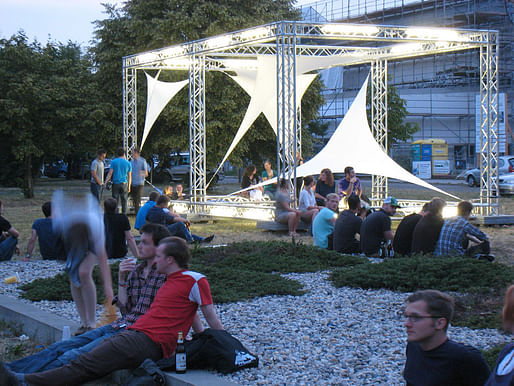

Sabrina Kolar, graduate architecture student at Brandenburg University of Technology in Cottbus, Germany, has sent us images of the temporary membrane sculpture "Mettre" which was exhibited on the school's campus earlier this June. The sculpture design followed an internal, studio-wide competition for students of architecture and structural engineering in which Kolar, together with fellow student Ben Strachotta, was awarded the First Prize. The winning proposal was then further worked out within the studio project "Flying Surfaces" and finally realized.
Here's a more detailed project description from the designers:
Mettre: French for use, make, and create.
This single word is the inspiration for the design and construction of the Flying Surfaces sculpture for the 20th Anniversary of BTU Cottbus.The sculpture was specifically designed to be ‘hands on’ allowing people to use, touch, explored, and view from every angle. Allowing people the chance to fully ‘experience’ the sculpture. The design allows for every exterior to have a different perspective from any point of the interior, thus creating a different picture for each individual. This is done through the lack of a fixed input/output point of the sculpture. It is left to the individual to choose their perspective how they will experience the sculpture. There are two hammocks, which serve as a rest and relax point on the sculpture itself, allowing people to fully immerse themselves within the sculpture. The hammocks were specifically made of a blue membrane fabric, connecting it to the official color of the architecture faculty at the BTU (Brandenburg University of Technology, Cottbus, Germany).
Structurally, the membrane surfaces connect to a sway frame which serves as a primary structure. All the various tension forces resulting from the membrane sails which differ greatly in magnitude, location and direction get balanced out within the frame. Consequently, there are no overall tension forces acting on the ground. This was one of the main requirements since the sculpture was erected above a major underground services route which did not allow the use of ground anchors. Normally for membrane structures, this would have been the typical solution. The sway frame also does provide the stability to the structure. Uplift of the frame is prevented by three layers of concrete pavement slabs stacked around each footing.
The Flying Surfaces sculpture is the outcome of a multidisciplinary design workshop involving students of the three disciplines architecture, structural engineering and business engineering. The project was funded by sponsoring only. The three main sponsors are the Max-Grünebaum-Stiftung, the tent manufacturer TEGE and the event management company MMC.
The project was supervised by Dipl.-Ing. Jens Metz (architecture) and Dipl.-Ing. Frank Ohm (structural and seminar leader). The chairs in charge were Building Construction and Design (Prof. Dipl.-Ing. Wolfgang Schuster) and Structural Engineering and Building Structures (Prof. Karen Eisenloffel M.Sc.).
Are you sure you want to block this user and hide all related comments throughout the site?
No Comments
Archinect
This is your first comment on Archinect. Your comment will be visible once approved.